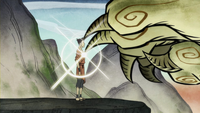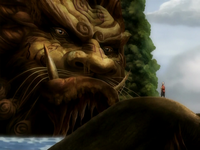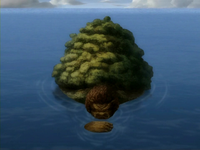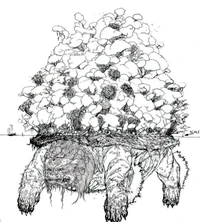| "The world is entering a new age. Our time protecting mankind is over. We will no longer give humans the power of the elements." |
| — A fire lion turtle announcing the departure of his kind.[1] |
The lion turtle, also called Ancient One by the spirits,[1] is a chimerical hybrid of a lion and a turtle and the largest known animal in the world. In the era of Raava, lion turtles populated the Spirit Wilds, where they served as protectors of mankind by housing human cities on their backs.[2] As indicated by the symbols on their foreheads, lion turtles showed affinity for one of the four bending arts and possessed the ability to grant individuals with the power to control the specific element to which they were attributed.[1]
Quick Answers

What is the significance of the symbols on the foreheads of the lion turtles?

How did the lion turtles serve as protectors of mankind in the era of Raava?

What is the connection between the lion turtle and the concept of energybending?

How many lion turtles are known to exist in the world of Avatar?

What is the meaning behind the lion turtle being referred to as the 'Ancient One' by the spirits?

History
Era of Raava
In the era of Raava, lion turtles developed a relationship with humans, who established settlements on their backs as a means of protection against spirits who roamed the wilds. Due to their role as protectors of mankind, lion turtles also ascertained the safety of humans who ventured away from the cities to gather food by granting them with the ability to bend an element, which they would relinquish upon their return. As solitary creatures, lion turtles rarely interacted with other members of their species, which resulted in the complete isolation of individual settlements from one another to the point where humans were unaware of the existence of other lion turtle cities.[2]

A fire lion turtle granted Wan the power of fire to aid him in protecting himself while in the Spirit Wilds.
Around 9,832 BG, a group of hunters approached a fire lion turtle who granted them with the power of fire to find food for the village. Among the company was Wan, who refused to relinquish his bending. As a result, he was brought before the lion turtle, and although the creature permitted him to keep his firebending at his request, Wan was banished to the Spirit Wilds for his crimes. During his banishment, Wan befriended the spirits and learned about the existence of other lion turtle cities, which he left to find. Inspired by Wan's success at surviving in the wilds, many other villagers requested the power of fire from the lion turtle and left the protection of the city to establish settlements in the Spirit Wilds.[1]
During his travels, Wan came across harvesters with the power of air and followed them to a city on top of a flying lion turtle. Following an attack by dark spirits on the air lion turtle's settlement, Wan undertook the task of helping Raava defeat Vaatu during the next Harmonic Convergence. In order to do so, he requested the power of air from the lion turtle, who was reluctant to grant him the ability as no human had previously held more than one element. After agreeing to allow Raava to hold the element until he mastered it, Wan left the air lion turtle's city in order to find settlements with guardians that could grant him with the remaining elements. Over the course of the next year, Wan found water and earth lion turtles who provided him with the power of water and earth, respectively.[1]
After Wan and Raava merged permanently to defeat Vaatu, the lion turtles collectively decided to relinquish their role as protectors of mankind and refrain from further granting the power of the elements to humans.[1]
Era of the Avatar

The last remaining lion turtle gave Aang advice shortly before the arrival of Sozin's Comet in 100 AG.
Lion turtles were hunted to near extinction over the thousands of years following the start of the Avatar Cycle until one remained.[3] In order to protect himself from being hunted, the last remaining lion turtle opted to travel the world away from human civilizations. Having developed a lush forest on its back over the course of its lifetime, the lion turtle avoided human contact by appearing as an island until he encountered Aang on the shores of Ember Island in 100 AG. The young Avatar stumbled onto the lion turtle subconsciously in the dead of night and awoke the following day unaware of his whereabouts.[4]
After convening with his past lives regarding the course of action he should take to defeat Fire Lord Ozai, Aang discovered that the island in which he believed himself to be stranded was in fact a lion turtle and proceeded to ask the creature for advice. After noting that darkness always yields itself to purifying light, the lion turtle imparted Aang with the ancient art of energybending, stating that individuals originally bent the energy within themselves as opposed to the elements. He warned Aang that the use of the art requires having an unbendable spirit, before leaving the young Avatar and Momo on the shores of the Earth Kingdom near Wulong Forest.[5]
Anatomy

Adult lion turtles will eventually grow a forest on their backs, giving them the same appearance as a small island.
The majority of the lion turtle's body resembles the anatomy of a turtle with face and paws similar to that of a lion. The creature has webbed feet with finger joints made of soft tissue, similar in function to joint covers present in crabs. Young lion turtles are significantly smaller in size than their adult counterparts but still considerably large, growing to the size of an adult flying bison.
Lion turtles can survive for centuries if unharmed and reach the size of a small island, developing hard shells that eventually grow plant life that can sustain several species of animals.[6] This effectively creates small ecosystems on the backs of lion turtles, which neither benefit nor harm the hosts in question.[7] Lion turtles are so enormous that their hearts can weigh over 120 tons, which is comparable to the combined weight of twelve flying bison.[8]
Although from the same species, lion turtles have distinct markings on their foreheads indicating the element to which they are attributed: lion turtles associated with fire have two swirls curling inward, forming a shape similar to a heart; lion turtles associated with air have a more intricate swirling pattern, with two swirls curling outward and a swirl in the center; lion turtles associated with water have three wavy lines increasing in length from top to bottom and a lone swirl underneath; and lion turtles associated with earth have a singular swirl diverging into two smaller swirls, with the one on top larger than the other, forming a shape similar to a question mark. In addition, the lion turtles associated with earth have two swirls on each upper cheek and two others near their ears.[1]
Behavior
Lion turtles are intelligent creatures who demonstrate the ability to both speak and understand human language, unlike many other creatures in the Avatar World.[4] They are solitary creatures that disperse as much as possible and remain hidden through various means. Terrestrial lion turtles buried themselves in the ground and did not surface unless summoned, while aquatic lion turtles partly submerged themselves underwater to avoid detection. Lion turtles associated with air also had the ability to fly and remained afloat for additional protection.[1]
Connection
The lion turtle bears a strong resemblance to both of its namesakes, the lion and the turtle. Most of the creature's anatomy is based off the body of a turtle, with the head and limbs similar in appearance to a lion.
Trivia
- Lion turtles have great cultural importance in the Avatar World and are referenced several times throughout the franchise.
- A painting of a lion turtle was depicted in a scroll inside Wan Shi Tong's Library.[7]
- A fountain at the Northern Air Temple was in the shape of a lion turtle.[9]
- Piandao compared Sokka's courage and heart to those of a lion turtle. Additionally, his manor boasted many lion turtle furnishings.[10]
- Admiral Chan's home in Ember Island had a lion turtle door knocker.[11]
- General Fong and General Sung both had pauldrons representing the head of a lion turtle, as did one of Aang's battle "options".[12]
- Aang and Sokka hid behind a lion turtle statue outside the Earth Kingdom Royal Palace while devising a plan to meet Earth King Kuei.
- Statues of a lion turtle were seen when Sokka and Katara were searching for clues in Kyoshi Island.[13]
- The gates of the Southern Water Tribe compound have a lion turtle motif.[14]
- A Satomobile used by the Triple Threat Triad sported a golden lion turtle as a hood ornament.[14]
- A lion turtle fountain stands next to the pool in Hiroshi Sato's estate.[15]

An early sketch of a lion turtle emphasizes its enormous size by providing a scale.
- A very high level of detail went into the lion turtle's design in early production of the first series, but it was not rendered as intricately in the final animation.[16]
- The lion turtle resembles Chinese mythological turtles, a few of which are placed around the Forbidden Palace in Beijing.
- The chanting heard when the lion turtle called to Aang is a Buddhist chant known as "Na Mo A Mi Tuo Fo Shin Di". This chanting was first heard when the Fire Sages assumed their stances in front of the door to the Fire Temple sanctuary.[17] It was heard again right before Aang stepped into the Spirit Oasis to fuse with La during the Siege of the North.[18]
- Nyla was unable to follow Aang's scent while he was on the lion turtle, as it had traveled extensively throughout the world. Because of this, the lion turtle accumulated countless smells which made it impossible to differentiate between distinct scents, effectively masking Aang.[19]
- A lion turtle appeared in the beginning of the unaired pilot as a statue behind Aang.
- The lion turtle who imparted Aang with energybending had forehead markings similar to those seen on fire lion turtles.[2]
- Some critics claim that the lion turtle teaching Aang energybending to defeat Ozai without killing him was a deus ex machina, a device used by writers to resolve a conflict through some form of divine intervention. The creators refute this claim and insist that the lion turtle's abilities were already developed prior to its introduction.[20]
- The lion turtle is the only creature and character to be painted, as opposed to drawn as a cartoon.